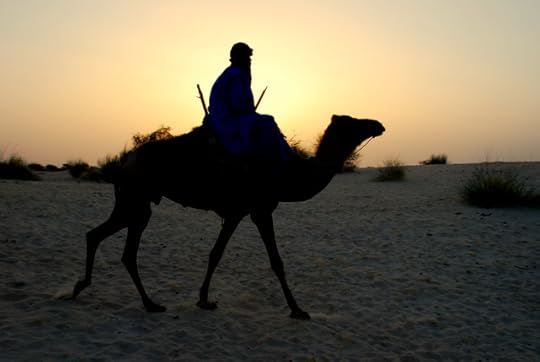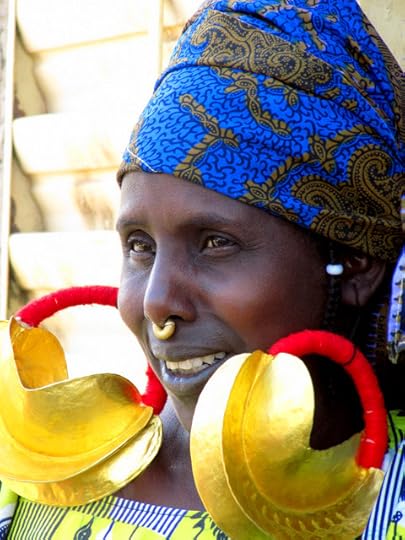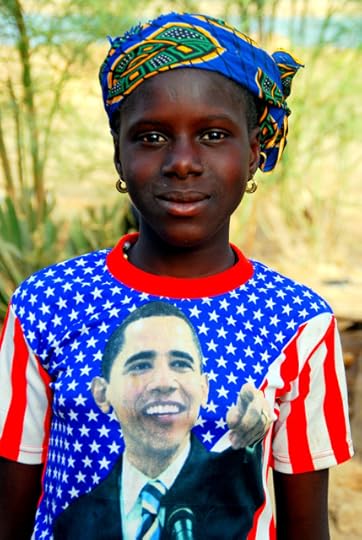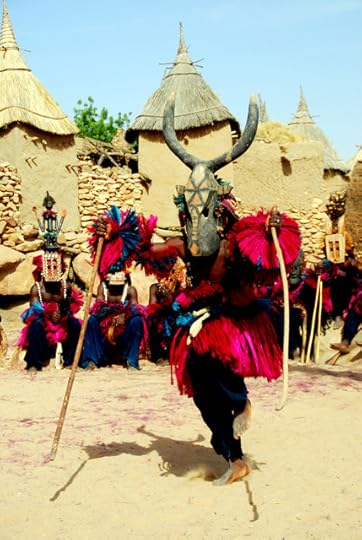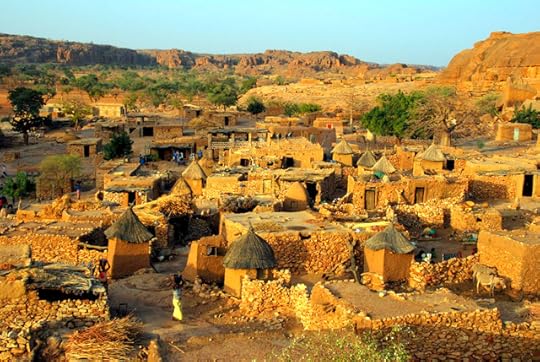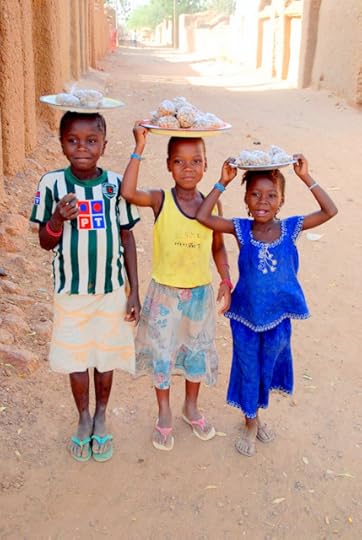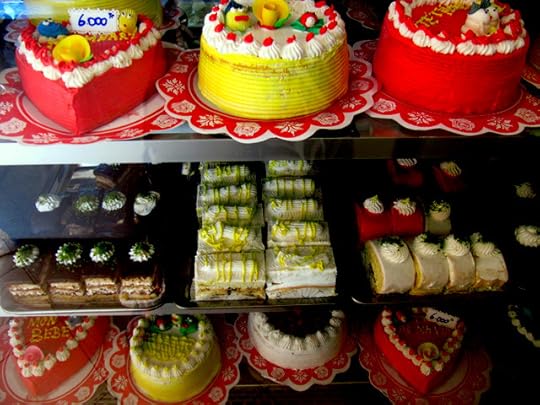Roderick Phillips's Blog, page 16
February 23, 2014
Timbuktu, Mali, Day 210
The airport serving Mopti and Sevare is a fairly dilapidated affair and the usual rows of airport seating are all located outside of the small terminal building. Our flight is scheduled to depart at 7 am, but Granpere told us not to go to the airport until 7:30 am. This is only a contradiction for non-Malians. Apparently nobody in Africa turns up for their flights on time, so the airlines fib to their passengers – in this case assuring them that the flight departs at 7 am when in fact it leaves at 8 am. This normally works well, but not today as our flight (which originated in Bamako, the capital of Mali) is delayed for an altogether more familiar reason: engine problems. We are therefore 90 minutes late leaving Mopti / Sevare airport, shaving precious minutes off our very brief time in Timbuktu (we leave again early tomorrow morning). The 45-minute flight aboard a 33-seater twin-propeller plane (with a white pilot, note) is reassuringly smooth. We are even served a croissant and juice, while gazing down at the surprisingly large expanse of the Niger inland delta and its associated waterways.
Granpere has arranged our accommodation, a city tour, and an airport pick-up. Granpere’s fixer in Timbuktu goes by the disturbing name of Ali the Ice. Stan and Sinead are pooling resources and doing everything first class. They are staying at the luxury La Maison (twin-bed room is CFA 40,000 [US$80]) whereas Christi and I are a little ways out of town at the less glamorous Camping La Paix Hotel (The Peace Camp Hotel) for CFA 15,000 (US$30). The hotel is named for the nearby monument (dilapidated but under repair) that celebrates peace between the Tuareg and the government after 5 years of conflict in the mid 1990’s. The Tuareg are members of the Berber ethnic groupings and are indigenous to North Africa. They predate the arrival of the Arabs from the Middle East by thousands of years. The Tuareg are fiercly independent nomads who are constantly demanding more autonomy from central government. This frequently flares into fighting. (Note after the Arab Spring uprising in Libya in 2011, many Libyan fighters and Al-Qaeda supporters fled to the northern deserts of Mali and fought alongside the Tuareg [at least initially] to overthrow the Malian government in early 2012. France quickly sent in troops to quell the uprising).
After checking in to our very basic accommodation, we head off into town to get that all-important Timbuktu stamp in our passports (note later during our travels an inconsiderate Egyptian immigration officer placed a sticky visa right over my Timbuktu stamp – bummer). Timbuktu is not the most stylish of destinations – there are no world class attractions here other than the name – but we wander around anyway in the company of Ali the Ice. And we do it in the brutal heat of the Timbuktu sun. Large clay ovens dot the streets which are used for making bread, while in another shaded street carpenters originally from Yemen carve Moroccan style window frames that are a common sight in the city. The streets of Timbuktu are covered in sand that blows in constantly from the Sahara, but this merely adds to its mystique. A mystique that goes back hundreds of years as European adventurers tried and failed to reach the fabled city. The first European to see Timbuktu was the British adventurer Gordon Laing, in 1826. Even then the city had already begun to fall into decay. Sadly for Laing he was murdered on his way back to civilization by the Tuareg because he would not convert to Islam. A plaque still marks the house in which Laing stayed in Timbuktu.
We begin our tour of Timbuktu with visits to the three main mosques (all of which are Sudanes-style mud mosques): the Dyingerey Ber mosque (also under scaffolding), which dates to the 14th century and is one of the oldest in West Africa. Unfortunately we are not allowed in. Second is the Sidi Yahiya mosque (named after one of the 333 saints to have lived in Timbuktu) built in 1400. Third is the Sankore mosque build a century after the Sidi Yahiya mosque. It is also a university and by the 16th century it was one of the largest schools of Arabic learning in the Muslim world. This mud mosque has recently been refaced – so recently, in fact, that the hand prints are still clearly visible.
We also visit the Ahmed Baba Institute of Historical Research, which holds some 23,000 historical, scientific, and religious texts dating as far back as the 11th century. A huge project is ongoing to protect, translate, and catalogue the collection currently running at 3,000 per year. There is also a unique Koranic manuscript dating to the 15th century that was recently copied by scholars from Mecca because it is a unique text.
Next up is the local market and then another highlight: afternoon tea with two Tuareg fighters, Alfa and Bashir. The tea is sharp and sweet, a bit like the Tuareg themselves. I certainly would not want to get on the wrong side of these guys. And this becomes a bit of an issue when they then try to sell us very expensive Tuareg jewelry. Fortunately, Stan Laurel buys something for his wife and we all survive the experience.
Our last adventure is a sunset / starlight camel safari in the Saharan desert surrounding Timbuktu. Our guides are Mohamed (who speaks pretty good English as do many others in Timbuktu) and his sidekick Sidi. Our camels are Edderie (mine is a brown dromedary) and Ebeditch (Christi’s is a white dromedary). Christi truly enjoys riding the ship of the desert, but I never feel comfortable sitting on other animals. Just getting on and the camel standing up is nerve-wracking enough for me.
More fascinating than the camel ride itself is listening to Mohamed and learning about his life. He participates in the caravan that goes to the salt mines 850 km to the north. Many Tuareg go on these journeys taking their camels with them. It takes 2 weeks to get there and they travel by night. Different members of the team have different jobs: navigating (by the stars), cooking, looking after the camels etc. Mohamed is the cook, but he is learning to navigate by the stars. The last caravan (some 400 camels) of the season arrived in Timbuktu from the salt mines 2 weeks ago. Mohamed has also visited Merzouga in Morocco – a journey that took him 52 days. Return to town by starlight; diner; bed at 9:30 pm. What a unique and fascinating day!
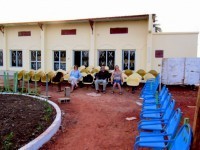
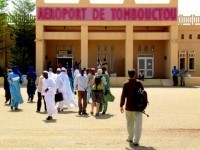
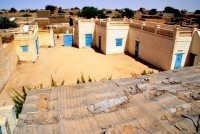
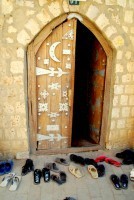
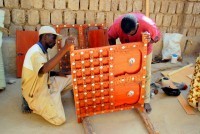
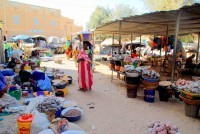
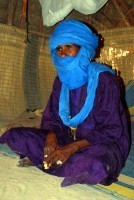
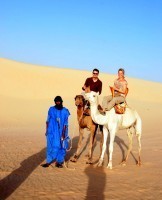
Blog post by Roderick Phillips, author of Weary Heart - a gut-wrenching tale of broken hearts and broken test tubes.
The post Timbuktu, Mali, Day 210 appeared first on Roderick Phillips.
February 22, 2014
Senossa to Sevare, Day 209
Considering Djenne is the jewel in West African tourism we spend very little time here. Of course that could partly be because Christi and I together with Sinead O’Connor and Stan Laurel are going to visit that great Saharan city of Timbuktu – a place deemed too unsafe for the Dragoman truck to visit so we have to sign off the tour for a few days. (And Adonis does literally make us sign forms absolving Dragoman from all responsibility for our independent / foolhardy activities) The four of us are going to fly, which seems eminently more sensible than the second group (comprising Sheldon Cooper, Buddha, Hu-man, and Agatha Christie) who are planning a 5-day round trip jeep trek (aesthetically purer, they argue!). The entire group gets a brief sense of what might be in store for the jeep group, when we board a convoy of horse and carts to visit the neighboring Fulani village of Senossa. Christi and I share a horribly bumpy and uncomfortable 5 km ride with Aphrodite, Thelma, and Oliver Hardy. Aphrodite continues to be an interesting character. According to Agatha Christi, Aphrodite takes the time each morning to bathe and apply make-up even though by the end of the day she looks as bedraggled as the rest of us. Apparently the romance with Adonis goes from strength to strength, so the English rose is taming the Italian stallion.
I digress. The hard wooden cart is painful on the rear end, but it ‘s the poor horse I feel sorry for. Its owner whips the animal repeatedly adding to the scars already prominently displayed on its scrawny back. Christi and I are thus relieved to reach Senossa for more than one reason. And it’s the usual chaos: lots of children screaming and yelling, alternately holding our hands and then asking for presents or demanding to have their photographs taken. Intermingled with this are the other members of the village who I suspect would be much happier if we were not there. Of course we have paid to visit Senossa and the local guides are constantly cajoling and bullying the villagers into posing for photographs. The poor things are suddenly faced by 20 camera lenses in a paparazzi-like scramble for that perfect, natural image. Instead the looks we get vary from scared to confused. (Another disadvantage to group travel).
We do have one very interesting experience in Senossa, however. Fulani earrings are a sight to behold. We meet the village jeweler and his wife who parades around in massive (and heavy) gold earrings. Typically, a man will have to sell several cows in order to purchase a suitably grand pair of earrings for his future wife. The bigger the earrings the more prestigious it is in Fulani culture (similar to large diamond engagement rings in Western culture!). Often a Fulani woman uses wool or silk to protect her ears and straps over her head to support the weight of heavy golden baubles.
The return horse and cart ride from Senossa to Djenne is equally unpleasant on our bums. We pass the town dump, which also appears to be the graveyard of ex-livestock: decomposing cows and donkeys are clearly visible. Across the road the locals are growing crops in their own individual allotments: potatoes, onions, cabbage and lettuce are common. Water from the Bani river is abundant and the crops are a dash of bright green in an otherwise parched landscape.
Later, Christi, Sinead O’Connor, Stan Laurel and I take an expensive 90-minute (US$120) taxi ride back towards Mopti ahead of our flight to Timbuktu tomorrow. Courtesy of Granpere, we are staying in the Hotel Via-Via in Sevare (on the Bandiagara to Mopti road). Our double room with fan is another CFA 15,000 (US$30) while dinner and drinks are a further CFA 9,000 (US$18). Money is disappearing at an alarming rate at the moment. Still, this is our once in a lifetime shot at visiting Timbuktu and we are away from the claustrophobic confines of the truck for a while, thank goodness.
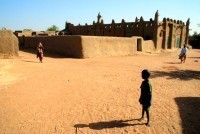
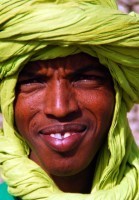
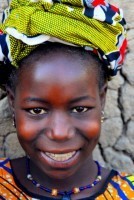
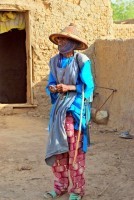
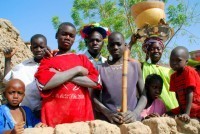

Blog post by Roderick Phillips, author of Weary Heart – a gut-wrenching tale of broken hearts and broken test tubes.
The post Senossa to Sevare, Day 209 appeared first on Roderick Phillips.
February 21, 2014
Niger River to Djenne, Day 208
Christi and I sleep remarkably well on the banks of the Niger River, but packing up the campsite in preparation for onward travel to our destination for the evening, Djenne, is problematic. Our tour group is acting more like toddlers at a daycare center – no one wants to give up their new toy. In this case the cool, refreshing (but not necessarily safe) waters of the Niger River. Sheldon Cooper, Stan Laurel, and Joan Rivers are the worst culprits.
Speeding up river creates a wonderful breeze that helps dissipate the heat – at least until the propeller hits underwater rocks with a resounding thud and we suddenly can’t navigate effectively. Somehow the crew steer our pinasse ashore and then set about the task of banging the bent rudder back into shape. For a brief moment I’m reminded of our painful journey up river to Angel Falls in Venezuela (Why don’t boats carry a spare rudder, I want to ask, but dare not!). This time, however, the crew fixes the equipment in double-quick time and we’re soon back to being voyeurs on the Niger River: fishing boats, villages on the move, laundry day.
We also stop at a second Bozo village, and much like yesterday we are greeted with kindness and curiosity. We reciprocate with respect and interest and again both groups appear to enjoy the exchanges. Agatha Christie goes above and beyond in this respect by discreetly handing over the bra she is wearing to a heavily pregnant Bozo lady.
Our lunch stop and jumping off point is the village of Kouakourou. In theory we are going to explore this community as well, but Adonis bounces into town amid a huge mushroom cloud of dust to inform us that the famous market in Djenne has been brought forward a day. Tomorrow the President of Mali is visiting Djenne and the market has been cancelled for security reasons. A much smaller maket has been hastily arranged by the locals for today, but we are at least 2 hours away from Djenne. The ride proves to be one of the dirtiest, dustiest, and bumpiest of the whole trip; we are caked in sand by the time we reach Djenne. Amazingly Buddha has a box of face masks, which at least stops prevents the excesses of the Malian Sahel from entering our lungs.
Djenne is packed with tourists and government officials sent there to pave the way for the President’s visit. For this reason we are relegated to the roof of the Campement Hotel Djenne. It’s like being in Dogon Country all over again, only this time we are using tents. And once the tents are up, Christi and I dash off to catch the last fading glow of the famous market. Once at the market we find the locals are dressed in some seriously stylish, brightly colored costumes which are dazzling on the eye. Our eyes are not the only sesnes we engage at the market, however. There is an over-powering aroma of fish paste balls, which stick in my throat and make me want to wretch.
In addition to the market Djenne is famous the world over for being home to the largest mud mosque in the world. The Grand Mosque at Djenne is the photographic highlight of the entire trip…but the news is dire. We’ve arrived during a periodic refacing of the structure. Consequently, scaffolding is scarring much of the Grand Mosque. I’m so disappointed. Christi allows me a brief moment of maudlin self-pity before tongue-lashing me back into shape. “Just get on with it!” she yells. I walk around the mosque, studying angles, and isolating elements. I realize that with a little creativity it might be possible to avoid most of the ugly scars. I should probably thank Christi, but I don’t. I mean it was still a tongue-lashing.
We’re dragged away from the market far too quickly (the organized tour effect again) to embark upon a tour of Djenne. Our guide, who goes by the bizarre name of ‘Sorry’, shows us around the dusty streets and alleyways of Djenne explaining about the Islamic schools, secular schools, a new library and the fact that many ethnic groupings including the Fulani, Bozo, and Bambara (all Moslems) live in perfect harmony.
Dinner is off the truck again so Christi and I wander back into the town center. We quickly find a food-stall where a lamb is being roasted and we eat several delicious slices. Finally at the end of a long, exhausting day we step into deliciously cool showers and watch the dirt and dust roll off our bodies. Exploring West Africa is damned hard work!
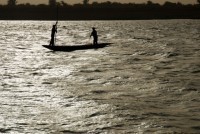
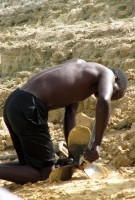
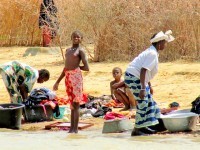
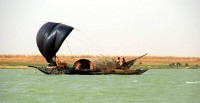
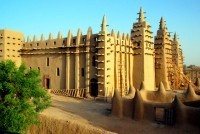
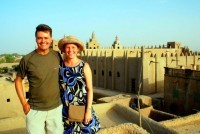
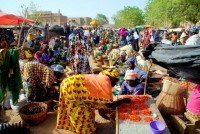
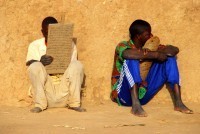
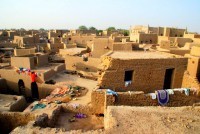
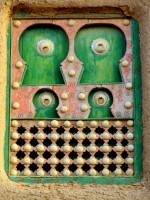


Blog post by Roderick Phillips, author of Weary Heart – a gut-wrenching tale of broken hearts and broken test tubes.
The post Niger River to Djenne, Day 208 appeared first on Roderick Phillips.
February 20, 2014
Songo and the Niger River, Mali, Day 207
There’s no rest for the wicked. I’m up at sparrow fart (a.k.a dawn) loading bags onto the truck and also putting a separate day pack together (tonight we’ll be off the truck camping on the banks of the Niger River ). Eat a rushed breakfast and we leave Bandiagara at 7 am. Our first stop is the village of Songo, another perfect picture-postcard Dogon community (the rubbish aside). This village is also part of the tourist trail and the locals are used to the attention of camera-toting visitors. After the obligatory ‘Bonjour. Ca va?’ (Good morning. How are you?’), the next word the children utter is ‘cadeau’ (present) and their hands shoot out from their hips faster than a gunslinger. The children do genuinely seem interested in us, though, and it doesn’t take long for the kids to find an exposed white hand to hold and they hang on for dear life. Most of us are happy to engage in some cross-cultural fraternization (but remember to use that hand sanitizer afterwards!) aside from Dennis and Margaret Thatcher who shoo the kids away most vigorously.
Although theoretically Islamic, the Dogon still practice male (but not female) circumcision. Every 3 years the teenage boys are taken to an enclave above the village where the rite is performed. A wrestling match precedes the ceremony and the winner is accorded the ‘honor’ of going first. As in most cultures that perform circumcision it is the village blacksmith who performs the dirty deed. The boys remain in the enclave for one month to heal and during this time they create their own individual rock art to add to the generations of images on display. Our stay in Songo is brief, but I’m sure another tour group will pass by very soon. And perhaps those tourists will have a cadeau or two to share.
At this point I need to make a literary detour to catch you up with the latest geo-political developments in West Africa. If you recall Christi and I had planned to do back to back 5-week trips aboard the Dragoman truck with the second outing covering Mauritania and Morocco. However, Mauritania was deemed too dangerous because some Western food aid workers had been kidnapped. Apparently the discontent in Mauritania is spreading to Northern Mali and our dream of floating down the Niger to Timbuktu has been officially abandoned. The British Foreign Office advises tourists to avoid this mythic desert outpost and Dragoman cannot, for insurance reasons, ignore government directives. Our Niger cruise is therefore commuted to a quick overnight trip. We board our cruise liner at the town of Mopti. Cruise liner may be a bit of an exaggeration: it’s actually a leaky pinasse (large covered motorized canoe) that has to accommodate 19 Dragoman passengers and luggage, Granpere, a cook, the Dragoman equipment (tents etc.), and 3 crew members.
But wait, Granpere is not known as a fixer extraordinaire without good reason. If any of the passengers wish to risk a trip to Timbuktu, he is offering two options. The first is a cheap but rough 5-day round trip jeep excursion, which amazing as it sounds actually appeals to some people. The other option is to throw money at the situation (always my preferred solution). Flights are still going to and from Timbuktu and before we leave Mopti Granpere flashes 4 airline tickets at myself, Christi, Stan Laurel and Sinead O’Connor. Granpere assures us that Timbuktu is safe and the troubles are hundreds of miles away (but edging closer daily). Adonis warns us that we must temporarily sign off the Dragoman tour if we choose to go to Timbuktu – and then smiles and wishes us good luck.
Our Niger cruise becomes fun again, a mouth-watering amuse-bouche before visiting the mythic desert outpost of Timbuktu. Gliding up the Niger River is a great way to watch the people of Mali at work and play (lots of clothes being washed, fishing etc.) along this major African waterway. And because the canoe is motorized we do actually move quite quickly through the aquamarine waters of the Niger. At this time of year, though, the Niger River is very shallow in places, perhaps only 0.5m deep, so the crew have to be constantly checking the depth of the water around us. Our first stop is the Fulani (one of the largest ethnic groups in Africa) village of Ngongme. Christi prefers to remain on the boat, whereas I’m off chasing photos of yet another spectacular mud mosque. Along the way I meet many local Fulani women and children who seem as genuninely curious about me as I am about them. Fortunately this curiosity is not associated with the persistent and annoying request for a ‘cadeau’. Fulani women of marriageable age (perhaps 15 onwards) decorate the area around their mouths with a black charcoal tattoo. It is an advertisement of their desire and availability for marriage. And with a little gentle persuasion and much laughter I’m allowed to photograph one of them.
Our last excursion of the day is a visit to a Bozo village. The Bozo are a different ethnic grouping to the Fulani. The Bozo tend to wander the Niger River, relying on fish as the main staple of their diet (rather than the nomadic pastoralist – predominantly cattle herding – lifestyle of the Fulani. In fact, it’s possible to see a whole Bozo village packed aboard pinasses moving along the Niger looking for a suitable location to stop for a few days or weeks. We do this ourselves, eventually, pulling ashore along a sandy river bank. Unfortunately we demonstrate none of the grace and style of the Fulani and Bozo and our little tent village sticks out like a sore thumb. But it is warm and relaxing beside the banks of the river and I’m soothed to sleep by the gentle lapping sound of the river. Either that or Buddha is taking a very long pee right outside our tent.
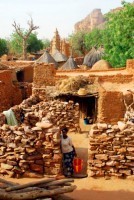
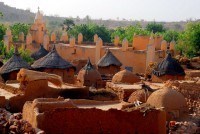
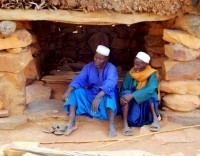
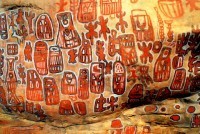
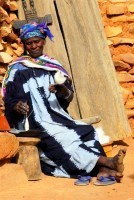
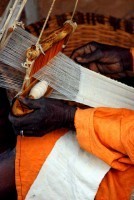
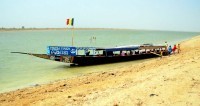
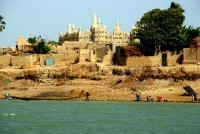
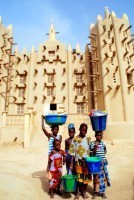
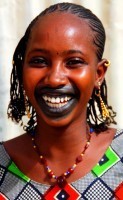
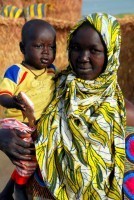
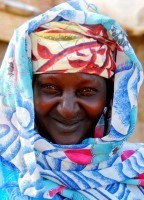

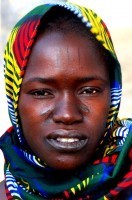
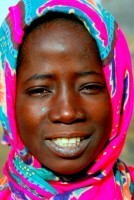
Blog post by Roderick Phillips, author of Weary Heart - a gut-wrenching tale of broken hearts and broken test tubes
The post Songo and the Niger River, Mali, Day 207 appeared first on Roderick Phillips.
February 17, 2014
Dogon trek, Mali, Days 204-206
Christi and I enjoyed a surprisingly comfortable night under the stars on our rooftop mattresses. As usual it was so warm that neither of us required blankets. We pack, eat breakfast and then undertake a brief tour of Begnemato, a classic Dogon village. We wander through the narrow alleyways poking our heads into people’s homes and watching them pounding millet, collecting water, or breast-feeding. We have a great meeting with the village hunter who owns some ancient guns, old skulls, and a monkey that he somehow managed to capture. The villages have Christian, Moslem, and animist communities all apparently living in harmony. Granpere says fundamentally the Dogon are all animist with a complex system of beliefs. French anthropologists in particular have devoted their careers and written many books on the Dogon lifestyle, recounting the gory details of the serpent and the jackal and all the other components of the Dogon’s animist beliefs.
Granpere leads us on our first hike across the top of the escarpment. It’s 8 km from Begnemato to our next Dogon village, Dourou. We are promised cold drinks on completing this first morning hike, but the reality is that nothing can be kept truly cold in this brutal climate. Heat radiates off the escarpment especially in the middle of the day. At this time the only thing to do is to find whatever shade is available and try to remain as comfortable as possible.
We begin the 7 km hike to Nombori while there is still plenty of heat left in the day. And this is where we leave the escarpment and plunge into a steep, narrow canyon straight out of an Indiana Jones movie. We scramble down the trail over rocks and beneath overhanging trees until we emerge 30 minutes later onto a sandy plain dotted with trees that stretches out to an inland sea of sand dunes on the horizon. It is not the kind of environment in which one might normally expect to find green, lush vegetable gardens, but there they are, hugging the shade of the escarpment. In truth, it’s an idyllic, almost surreal, pastoral scene as the Dogon go about the business of watering their crops (including onions, cabbage, and lettuce), weeding (I always hated that job) and planting new seeds. It must be incredibly hard to maintain these vegetable gardens in such harsh, arid conditions.
The Dogon attempt to maintain their traditional way of life, despite the constant invasion of tourists (there are direct flights from Paris to Mopti – a town only an hour away from the escarpment – so it’s an easy trip for French anthropologists and French tourists who don’t even bother to walk between villages preferring the ease of 4WD vehicles). Indeed the Dogon trek is big business and we have to pay to be in Dogon country and to stay at the villages and eat the local food. In fact it is compulsory to stay in the villages and eat the local produce. We are a captive audience in a monopoly situation. The Dogon are,however, free to ignore us, which they do – the children aside who scream ‘cadeau’ whenever the next tour group steps into town. From a photography perspective the intransigence of the locals is disappointing. Sheldon Cooper is unfazed by this and brashly shoves his camera into the faces of anyone and everyone. Pee Wee Herman who is theoretically leading this trip (his first visit to Dogon Country, while Adonis remains with the truck on top of the escarpment, ), and Granpere (who is really running everything) tell me to mimic Sheldon. Forget privacy and personal space, they say. If you want photos be bold!
At least now it’s along a flat sandy path beneath myriad baobab trees, while endless children asking for presents. Some of our group insist on rushing through these hikes so that they can reach the next cold beer as quickly as possible, but it’s the journey and not the destination (unless you include beer as a destination) that is the attraction. Christi and I potter around at the back of the group. We are in no rush, especially in this heat.
The food in the villages is actually rather good and fresh. The lettuce and onions aren’t even picked until we arrive. So far each village has a very basic cold shower (maybe that is a reason to rush!) and a squat toilet. The actual process of ablutions is a challenge, but for a few minutes afterwards I do feel clean. And then I begin to sweat again. It’s another beautiful night under the stars, although tonight there is one long roof for all of us to share.
It’s an odd thing that there are no rivers visible, but periodically we come across a watering hole, which is used for the crops and to provide us, the haggard tourists with drinking water (once it has been purified). Today we have an 8 km morning hike from Nombori to Tireli. Tireli is perhaps the largest and most commercial of the villages that comprise the Dogon trek. The sodas here are actually cool. De-licious! Tireli is also where we get to see the famous Dogon mask dance. Although now geared towards tourists, it is still without doubt the most exciting and energetic traditional dancing that I have ever witnessed. The masks, handed down through the generations, are intricately carved and heavy – especially now during the heat of the day – and represent many different facets of Dogon life, including the mythical antelope, Walu, the kanaga (a double-barred cross), and the buffalo. The traditional funeral ceremony is a colorful extravaganza comprising a masquerade that essentially leads the souls of the departed to their final resting places through a series of ritual dances and rites. This is most definitely the highlight of our visit to Dogon country.
Unfortunately having been fed and entertained not to mention enjoying a relaxing nap, the last think I want to do is go hiking again. Needs must, however, when the devil drives (or at least when there is a schedule to keep) as our campsite is at Ireli some 7 km away. We hike a total of 15 km today in temperatures that rise to 50oC (1220F). And I hope you agree, dear reader, that Christi and I deserve a little sympathy, don’t we? Along the way to Ireli we stop at a watering hole and are surprised to see it teeming with Nile crocodiles. Granpere assures us that they don’t go after the Dogon (who regard the crocodiles as sacred) yet there is little else for them to eat. Granpere thinks theses modern-day dinosaurs may have converted to a vegetarian diet – more likely the villagers are apt to lose the occasional goat or sheep under mysterious circumstances. It’s a relief to reach Ireli because it means we have survived the majority of the Dogon trek. I’m so tired that for once I don’t shower – and feel all the worse for it.
We begin our final day in Dogon country with a walk through Ireli to see the cave dwellings of another indigenous group called the Tellem (known as pygmies in the West). When the Dogon arrived in the 14th century they ousted the Tellem who moved on to the jungles of Central Africa. It is believed that the reason the Tellem lived in caves in the escarpment was to avoid conversion (under penalty of death) to Islam from other tribes in the area.
Our last hike is 5 km from Ireli to Banani. By this point all we want is shade and cold drinks. We hang out until word comes that the truck is waiting for us at the top of the escarpment at the town of Sanga. All we have to do now is climb back up the damn escarpment and an elevation gain of 500 m over 2.5 km under a brutal sun is exhausting. Adonis is waiting for us with the first truly cold drinks we have tasted in days. There is much relief and celebration and then another painful, bumpy ride along the top of the escarpment back to the Auberge Kansaye in Bandiagara. There are proper showers, sit-down toilets, and more cold drinks. It’s the simple things you miss when traveling rough. Christi and I also upgrade ourselves to a room with a bed as opposed to sleeping on a roof. All seems right with the world and in an odd fusion of Malian and South American music we are serenaded asleep to the strains of the Cuban folk song, Guantanamera!
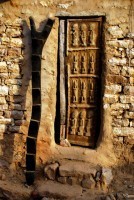
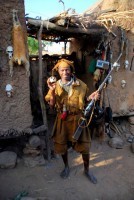
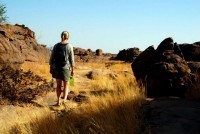
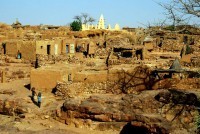
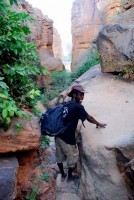
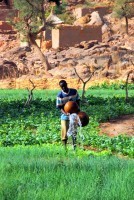

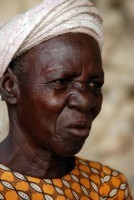
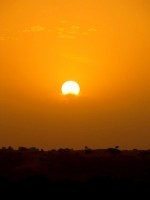
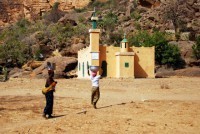
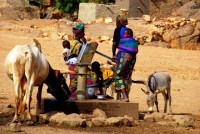
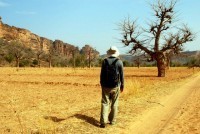
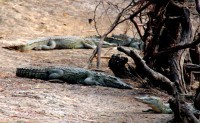
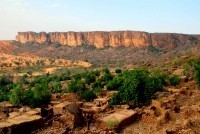

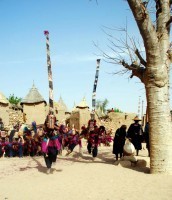
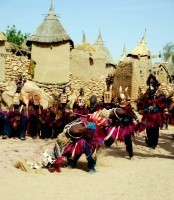


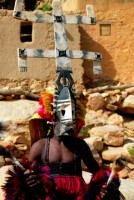
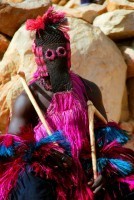


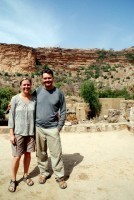
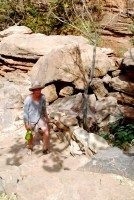
Blog post by Roderick Phillips, author of Weary Heart – a gut-wrenching tale of broken hearts and broken test tubes.
The post Dogon trek, Mali, Days 204-206 appeared first on Roderick Phillips.
February 16, 2014
Begnemato, Mali, Day 203
Oh my god! What a miserable night. I think a combination of hot weather, hot food, and a hot tent was more than my body could stand and it rebelled spectacularly: 5 night-time trips to the odious squat (no comfortable Western-style sit-down toilets here) for diarrhea and 1 for vomiting. I’m fairly certain this is not an infection, just a bad case of traveler’s diarrhea. God I feel terrible, but the Dragoman tour waits for no man. Sip a little tea at breakfast and then get the strength from somewhere to help load the bags into storage locker at the rear of the truck before collapsing onto a seat inside the truck. Our destination today is Begnemato and the start of a 3-day hike into Dogon country (a true highlight of Mali). Somehow I have to get better and quickly. It’s hot, of course, and I can find no relief from the miserable rebellion in my stomach or the hammer pounding inside my head. If all else fails, Christi promises me Immodium which will lock my bowels…indefinitely. Before we take such a dramatic step however, Christi resorts to her trusty box of pharmaceutical tricks and urges me to drink a rehydration pack dissolved in water. It’s like drinking salt water from the ocean. Once we reach our first stop of the day (market day in Bankass) Aphrodite offers me a freeze-dried cordial to help with the taste, but the combination is even worse causing me to vomit violently in a side alley. Fortunately, the rest of the group are exploring the town, leaving me to puke in peace. Remarkably the normally curious locals just ignore me. Feel much better after this latest vomit. Perhaps I have finally voided whatever nasty bug was inside me.
Our lunchtime stop is in Bandiagara at the Auberge Kansays and it is here that we are finally introduced to Granpere, fixer extraordinaire in Mali – at least according to Adonis. A fixer incidentally is a local expert and someone who knows how to get things done. They can, if they really know what they are doing, make your life much easier. Delicately nibble on a sandwich and then pack a bag to take with me for the trek into Dogon country. We begin our Dogon experience with a painfully bumpy ride in Tortuga (all Dragoman trucks have names!) along the rim of the escarpment. The road is truly terrible, which does nothing to ease my discomfort
Our first hike (only 30 minutes) is along the escarpment to Begnemato, a classic Dogon village. It’s about 4 pm and the ferocious heat is finally beginning to dissipate. The village sits on the top of the Bandiagara Escarpment overlooking the sandy plains of Dogon country, some 500m below us. The mud houses are wonderfully charismatic. Take sunset silhouette shot of Aphrodite who is in her element posing for the group on a rocky outcrop. Adonis looks on proudly, while Agatha Christie writes furiously in her notebook . We sleep literally on roofs in the village on mattresses provided by Granpere. Christi and I have the honeymoon suite (a roof to ourselves!). It’s another hot evening and we fall asleep staring up at a billion stars. The churning contents in my stomach have settled into a gentle ripple and I think I might just live!
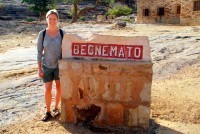
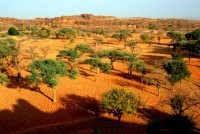
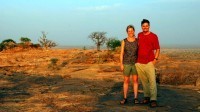

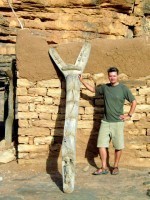

Blog post by Roderick Phillips, author of Weary Heart – a gut-wrenching tale of broken hearts and broken test tubes.
The post Begnemato, Mali, Day 203 appeared first on Roderick Phillips.
February 15, 2014
Koro, Mali, Day 202
Today is another all day drive as we leave Burkina Faso (Dragoman only devotes 5 days to this country!) and cross into Mali. Our destination for this evening is the small border town of Koro. Having said that Ouagadougou does not release its grip willingly. Junior partner PeeWee Herman fails to stop at a police checkpoint as we head out of town and the local officials chase after us in irate mood. Adonis orders PeeWee to keep driving. I’ve never been part of a car chase before let alone one that involves the police let alone in Africa. Of course the speeds are negligible because we’re in a 10-ton truck. Despite Adonis urging PeeWee not to stop he does eventually pull over and the car chase ends relatively quickly. The police are furious and want to board the truck. Adonis refuses and tells us all to close the windows. Adonis remonstrates with the police, telling them they must let us leave. The police insist we accompany them to the police station. This standoff really has nothing to do with law and order and everything to do with extortion. Once tempers calm down a little a hushed conversation ensues. Money changes hands and suddenly the police are all smiles and wishing us a safe journey. “Is the bribe coming out of the kitty?” Margaret Thatcher asks pointedly. “No,” Adonis replies, “PeeWee’s salary.” PeeWee pulls away from the scene of the crime looking suitably chatised. It’s a typical day in Africa.
The drive north is unbearably hot, but the rural scenery (villages, donkey carts, even camels) is pleasantly pastoral. From an eco-system perspective we are now in the Sahel (a belt of semi-arid grasslands and acacia savannas that lies just below the Sahara proper). It’s only going to get hotter and drier the further north we go. Border formalities are a breeze (CFA 15,000 [US$30] each for the Mali visa). We camp in the in the idyllic village of Koro. Sinead O’Connor and the Invisible Man are on cook duty tonight and if the temperatures are not already hot enough, they elect to cook a spicy curry. Gee thanks guys! Despite its isolation and harsh environment the people of Koro are friendly and it’s fun at the end of the day as the temperatures drop a little to stretch our legs and explore. The town has some beautiful architecture, especially the Sudanese-style mosque. Mali itself is known as the jewel of West African tourism and we have some fantastic adventures ahead of us, none of which sadly involve air-conditioning.
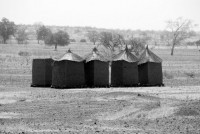
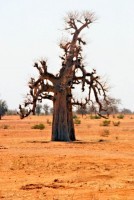
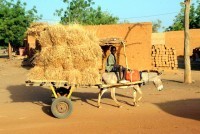
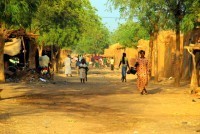
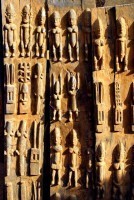
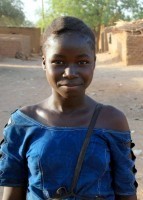
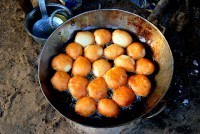
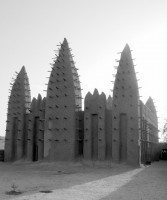
Blog post by Roderick Phillips, author of Weary Heart - a gut-wrenching tale of broken hearts and broken test tubes.
The post Koro, Mali, Day 202 appeared first on Roderick Phillips.
February 14, 2014
Ouagadougou, Burkina Faso, Day 201
Happy Valentines Day everyone! Although here in darkest, well hottest, Ouagadougou it’s not a day that appears to be celebrated. But being the clever, okay sneaky, bugger that I am I bought a card and some unmentionable undergarments while I was in Los Angeles. Christi is suitably impressed at my thoughtfulness, garnering me a much deserved brownie point. Remember this moment dear reader, it might just pre-sage bigger things to come.
Ouagadougou is hot. Did I already mention this? It’s a baking, draining kind of heat where all you want to do is sit in the shade, preferably with air-con and a cold, and I mean an ice-cold drink. Trouble is we have one day to explore the capital of Burkina Faso so it’s now or never. In temperatures of 102oF, though, exploration quickly loses its appeal in favour of an internet cafe with arctic levels of air conditioning. So instead of burning on the streets of Ouagadougou we’re now freezing in the cafe. Amazingly the internet connection is lightning fast and Christi uploads photos to Picasa, while I look to the future and life beyond the Dragoman truck. Is it even possible for wimpy travelers like Christi and I to travel around Africa by public transport?
One thing I do learn from surfing the net is that Ouagadougou is blessed with a profusion of French-style patisseries, which might make for an interesting Valentine’s Day date. Christi agrees. Finding one open on this Christian holiday is another matter and walking the streets with the sun beating down is miserable. It’s so hot that our sweat evaporates immediately leaving salt licks behind on our bodies. We are more than a little relieved to eventually stumble across a Turkish patisserie that is open. The shop is pleasantly cool – could you imagine trying to sell frosted cakes without air-con? Talk about kids in a candy store. Christi and I pig out on chocolate croissants, frosted pastries, cold drinks and even ice cream, all for CFA 4,000 (US$8). It’s definitely one of our more memorable Valentine’s Day celebrations.
Perhaps it’s because I’m now enjoying a monster sugar high, but I suggest exploring at least a few of the tourist attractions. Christi laughs at me and immediately returns to the internet cafe, but I gird my loins and follow in the heroic footsteps of some of the world’s greatest explorers, including Edmund Hillary, David Livingstone, and Robert Scott and set out to see something of Ouagadougou. I do find the Downtown Mosque, the Maison du Peuple (a culture an art venue) and the Place des Nations Unies (United Nations Square, which is outside the offices of FESPACO. Surprisingly this is not a guerilla or terrorist organization, but the organizers of Africa’s most prestigious film festival), before returning (exhausted) to Christi’s cybercafé.
Taxi back to the OK Inn hotel and immediately relocate to the pool where the water is fantastically refreshing – sheer bliss. Strangely, dinner is off the truck tonight and we have to forage for ourselves. Rather than eat in the hotel restaurant (which is expensive) we wander down to a local supermarket and grab a few goodies. Unlike the reserved Arabs of North Africa who prefer to socialize in private, Black Africa lives on the streets. The locals in Ouagadougou are extremely friendly: the streets are full of music, outdoor restaurants, and socializing.
It’s another baking night under canvas and while Christi and I try to sleep the locals are having much more fun than we are out on the streets of Ouaga.
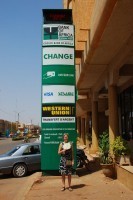


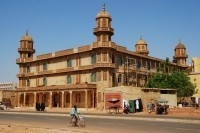
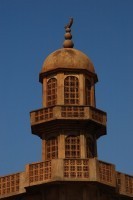

Blog post by Roderick Phillips, author of Weary Heart – a gut-wrenching tale of broken hearts and broken test tubes
The post Ouagadougou, Burkina Faso, Day 201 appeared first on Roderick Phillips.
February 13, 2014
Bobo-Dioulasso to Ouagadougou, Day 200
Before we leave Bobo-Dioulasso, Christi and I take the opportunity for a little more exploration. We want to soak up as much of the atmosphere from this wonderful town before moving on to the capital, Ouagadougou. It’s a pleasure to walk the somewhat dirty streets of Bobo-Dioulasso and watch the locals at work and play. I could definitely stay longer in this energetic but friendly town. In fact we’re enjoying the town so much we’re late back and the truck almost departs without us. I also receive evil looks from Doogie Howser and John Malkovich who had to store the packs without me.
It’s a six-hour ride to Ouagadougou (including a brief lunch stop) and while the road is in fairly good shape PeeWee Herman is rather an expert at hitting every pot hole we encounter, which puts the natives in a restless mood. Our collective mood is not helped by the heat, which, if anything, is getting hotter the further inland we go. We reach the Hotel OK Inn in Ouagadougou by late afternoon. Tomorrow is a holiday so plans are quickly made to visit a the museum of music (and for those on cooking detail) the local grocery store. Neither option appeals to Christi and I so after putting up our tents (no upgrades today, unfortunately) we hang out by the pool at the hotel instead, chatting to some of the other passengers.
Over the last few days I’ve gotten to know Dennis and Margaret Thatcher a bit better; mostly Dennis to be fair as Margaret prefers to scowl. This middle-aged couple fascinate me for their complete and utter selfishness and unwillingness to compromise (especially Margaret. The original Iron Lady would, no doubt, have approved) And they are completely honest about their views, which are completely un-PC, of course, but deliciously refreshing for all that. They have traveled extensively in their desire to collect all 220 official countries (although what constitutes a country is actually a rather gray area). Their tally to date is 150 (151 including Burkina Faso). Back in what passes for the real world, Dennis and Margaret live in the suburbs of London. He is a retired scientist, who is badgered every moment of the day by Margaret. They chose (wisely) to forgo children so that they can devote even more time and resources to enjoying themselves. They are an odd combination, but it seems to work for them so who am I judge. Margaret is not a team player, though, and trouble’s brewing, I fear…
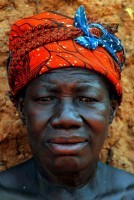
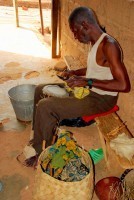
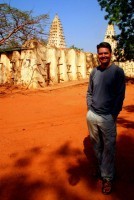
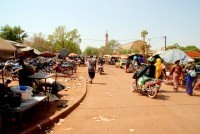
Blog post by Roderick Phillips, author of Weary Heart – a gut wrenching tale of broken hearts and broken test tubes.
The post Bobo-Dioulasso to Ouagadougou, Day 200 appeared first on Roderick Phillips.
February 12, 2014
Old Quarter, Bobo-Dioulasso, Day 199
Dragoman out of the goodness of its heart has given us a full day to explore Bobo-Dioulasso. Later we’ll take a tour of the Old Quarter, but first Christi has a yearning to visit the local market. It is the largest market in Burkina Faso and the hawkers and peddlers are the most persistent and aggressive we have encountered. I’m not sure that Christi and I had a particular agenda going in – and certainly not to purchase anything – yet we depart exhausted an hour later with an armful of souvenirs, including a fan and a full-length dress. The locals look very happy, which probably means they got the better of the deals. A Tuareg man even offers me an exquisite carved dagger for CFA 30,000 (US$60), which I nervously decline. He gives me a cold stare, but then disappears into the depths of the market. Refusing a Tuareg is a brave move let me tell you; these guys are tough desert fighters and don’t forgive perceived slights easily. (Note the Tuareg are not of Arab descent, but rather they are Berbers who are traditionally nomadic pastoralists and the principal inhabitants of the Sahara).
Later, after visiting the catholic cathedral and getting kicked out of the train station for taking photos Christi and I begin our tour of the Old Quarter in the company of a local Bobo guy called Ibraham. First up is the local Sudanese-style Grand Mosque which was built in 1880, making it the second oldest mud mosque in West Africa (after the mosque in Djenne, Mali). The interior is a rather basic affair – a few prayer mats with men dozing on them – but at least it’s pleasantly cool after the intense heat of the town.
The Old Quarter of Bobo-Dioulasso is a mix of animists, Muslims, Griots, and Forgeron that seem to live in relative harmony. We wander along many alleyways snooping into the private world of the villagers. We see a chief making drums, a woman stirring maize and cooking caterpillars (rather crunchy; not my favorite). We visit an animist house, which is used to resolve disputes and requires the use of fetishes. We try some millet beer, which Christi thinks tastes like cider, and finish off with some yummy donut bread. The oldest house in the Old Quarter (also known as Kibidwe) dates to the 11th century and is called kansasso. The River Houet runs through the center of Kibidwe and it is a disgusting rubbish-strewn, semi-stagnant stretch of water that amazingly supports many sacred catfish. And all the time we walk, we are surrounded by children staring, touching, posing for the camera, and asking for a cadeau (present). It is a fascinating day, but so intense that Christi and I are happy to escape back to relative calm of the hotel.
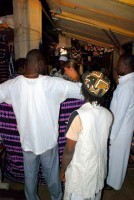
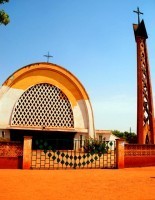
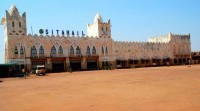
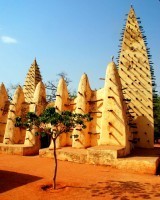
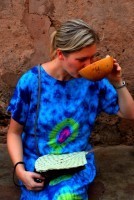
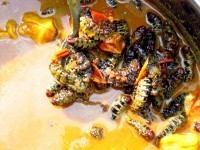
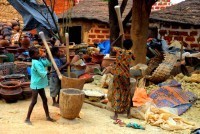
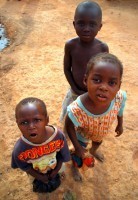
Blog post by Roderick Phillips, author of Weary Heart – a gut-wrenching tale of broken hearts and broken test tubes.
The post Old Quarter, Bobo-Dioulasso, Day 199 appeared first on Roderick Phillips.

